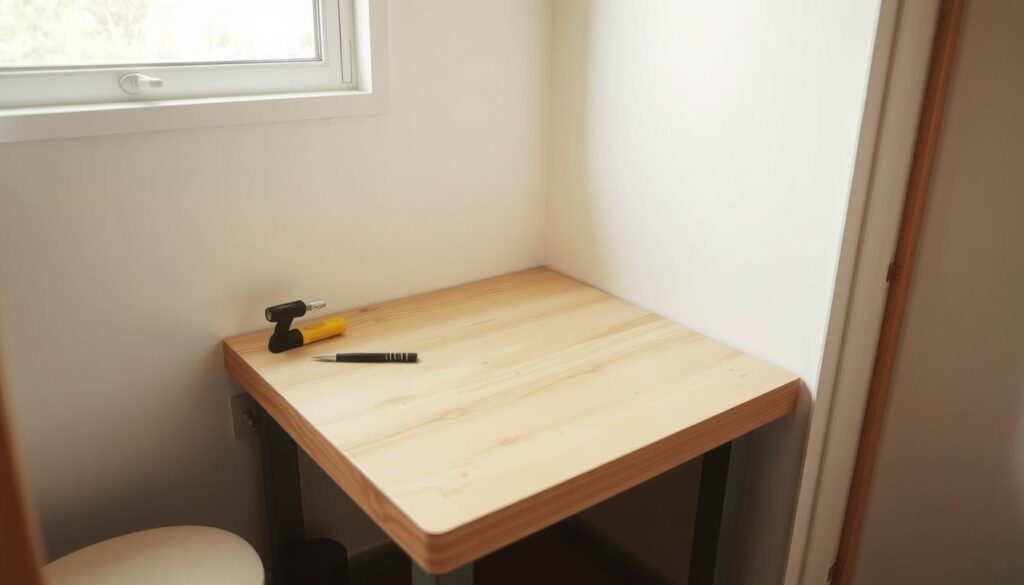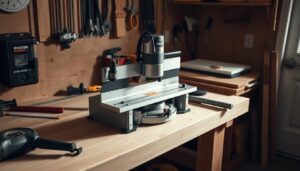Are you struggling to maximise your limited workshop area? Can a compact workbench really enhance your productivity? The answer lies in optimising your workspace with the right portable workbench. A well-designed workbench can transform your small garage or shed into a functional workshop.
You don’t have to sacrifice comfort or productivity for space. Modern workshop designs incorporate clever storage solutions, maintaining a small footprint while improving workflow efficiency. By choosing the right folding workbench, you can create a versatile workspace that suits your specific needs.
Key Takeaways
- Maximise your limited workshop area with a compact workbench.
- Improve workflow efficiency with clever storage solutions.
- Choose a versatile workspace that suits your specific needs.
- Optimise your workspace for productivity and comfort.
- Select a workbench that balances functionality and durability.
Why Space-Saving Workbenches Are Essential for Small Workshops
For DIY enthusiasts and professionals alike, limited workshop space poses a significant challenge. Many home workshops consist of a workbench loaded with tools, tucked into the corner of a garage or basement.
Even apartment dwellers with minimal space can benefit from compact workbench solutions. The challenges of working in small workshops are multifaceted, affecting productivity and workflow.
| Challenge | Impact | Solution |
|---|---|---|
| Limited workshop space | Reduced productivity | Space-saving workbenches |
| Inefficient tool storage | Poor workflow | Optimised tool organisation |
| Insufficient work surface | Difficulty in managing DIY projects | Multifunctional workbenches |
By adopting space-saving workbenches, you can maintain a functional workshop without sacrificing valuable floor space. This approach not only enhances productivity but also improves workflow by keeping tools and materials within easy reach.
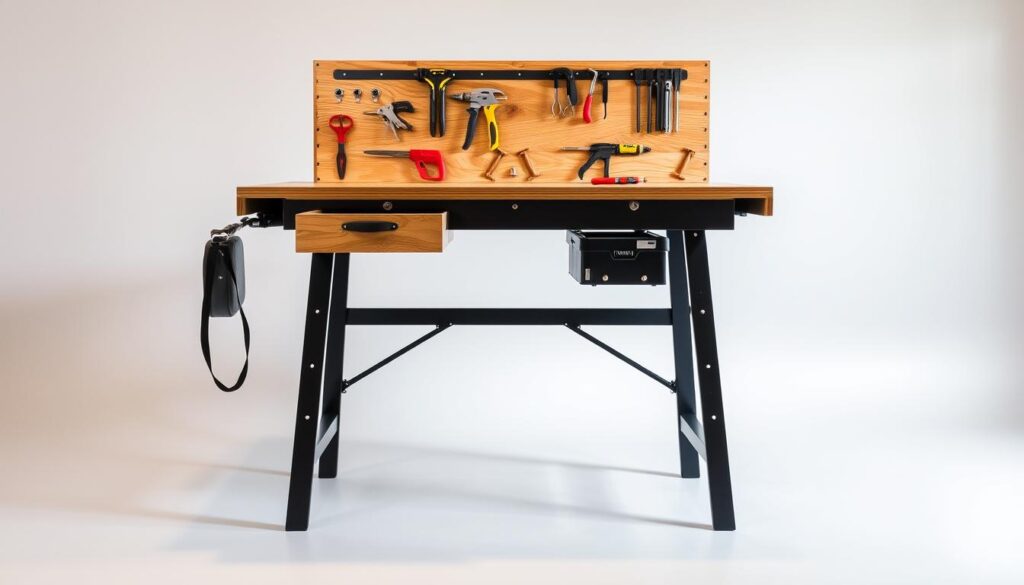
Wall-Mounted Folding Workbenches: The Ultimate Space-Savers
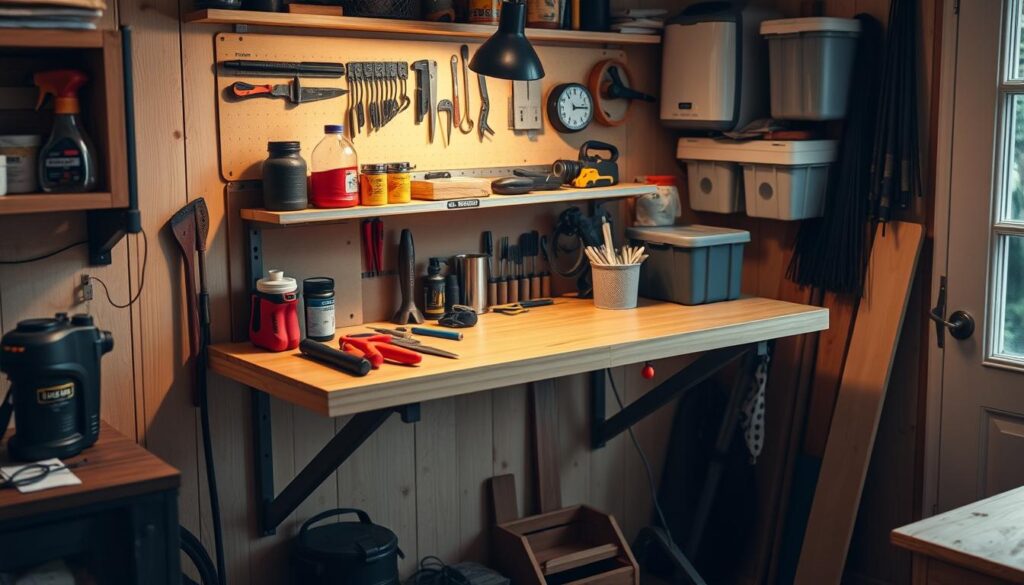
A wall-mounted folding workbench offers the ultimate solution for compact workspaces. By folding up against the wall when not in use, it provides maximum functionality while taking up minimal space.
Materials Needed
To build a DIY wall-mounted workbench, you’ll need a 3/4″ sheet of plywood, 2x4s, a piano hinge, and basic hardware. Selecting the right materials is crucial for ensuring the durability and stability of your workbench.
Installation Process
The installation involves creating an overhang for clamps, attaching the frame with pocket holes, mounting to wall studs, and adding folding legs with a stop block for stability. Following a step-by-step guide can simplify this process and ensure a sturdy result.
By understanding the materials needed and the installation process, you can create a wall-mounted folding workbench that meets your specific needs and enhances your workshop’s efficiency.
Compact Mobile Workbenches on Wheels

When working in small workshops, a compact mobile workbench on wheels can be a game-changer. It provides the flexibility to reconfigure your workspace as needed for different projects. You can easily move the workbench to various locations, improving your workflow and productivity.
Mobile workbenches with sizable work areas can fold up to only 7 inches thick when not in use, making them ideal for small workshops. The materials cost approximately $100 at home centers, and you can build one to suit your DIY needs by adjusting the frame sizes.
Benefits of Mobility
The key benefits of mobility in small workshops include improved workflow and the ability to work in different locations. This flexibility is essential for projects that require various tools and equipment.
Features to Look for
When selecting a mobile workbench, look for features such as storage drawers, locking mechanisms, and folding extensions. These features enhance the functionality and space-efficiency of the workbench, making it ideal for small workshops.
Flip-Top Workbenches for Tool Storage
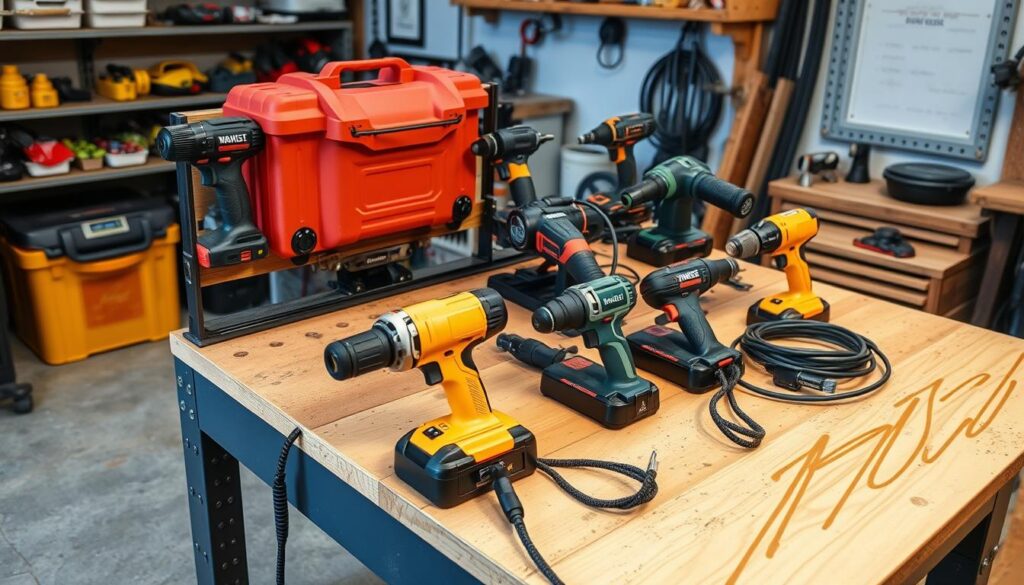
Maximise your workspace with a flip-top workbench, perfect for storing multiple bench-top tools. A flip-top workbench gives you a double platform for your bench-top tools, effectively doubling your workspace while keeping tools accessible.
Maximising Tool Access with Rotating Surfaces
The revolving center section of a flip-top workbench allows you to mount different tools on each side. This design enables quick switching between tools, enhancing productivity in your workshop.
Building Your Own Flip-Top Design
When building a DIY flip-top workbench, consider the weight and balance to ensure smooth operation. Choose durable materials for the rotating component and incorporate locking mechanisms for secure use.
Simple 2×4 Construction Workbenches

A 2×4 workbench is an excellent choice for those looking for a durable and easy-to-build workspace. You can create a robust workbench that rivals more expensive commercial options using simple 2×4 construction techniques.
Discover how simple 2×4 construction can create an incredibly sturdy workbench. Understand the complete materials list needed for this budget-friendly workbench.
Budget-Friendly Materials List
To build your 2×4 workbench, you will need the following materials: 2x4s for the legs and frame, a sheet of plywood or MDF for the work surface, screws, and wood glue. Ensure you select straight, quality 2x4s to keep your workbench square and stable.
Assembly Tips for Beginners
When assembling your workbench, start by cutting your 2x4s to the required lengths. Use a hand saw or a power saw, depending on your preference and available tools. Assemble the frame using screws, ensuring it is square before adding the work surface. Finally, attach the sheet of plywood or MDF to the top, securing it with screws.
To ensure stability, check that your workbench is level and make any necessary adjustments. You can also add additional support legs or brackets if needed.
Drop-Leaf Workbenches for Flexible Space

A drop-leaf workbench offers the flexibility to expand your workspace as needed. It’s a versatile solution for small workshops or garages where space is limited.
Expanding and Collapsing as Needed
The hinge mechanism is crucial for the smooth operation of a drop-leaf workbench. You can choose from various types, including piano hinges or sturdy butt hinges, depending on the size and weight of your workbench.
Mounting Options for Different Spaces
You can mount your drop-leaf workbench against a wall or design it as a free-standing unit. The choice depends on your available space and specific needs. Consider factors like stability and accessibility when deciding.
Portable Workbench Ideas for Small Spaces: Modular Systems
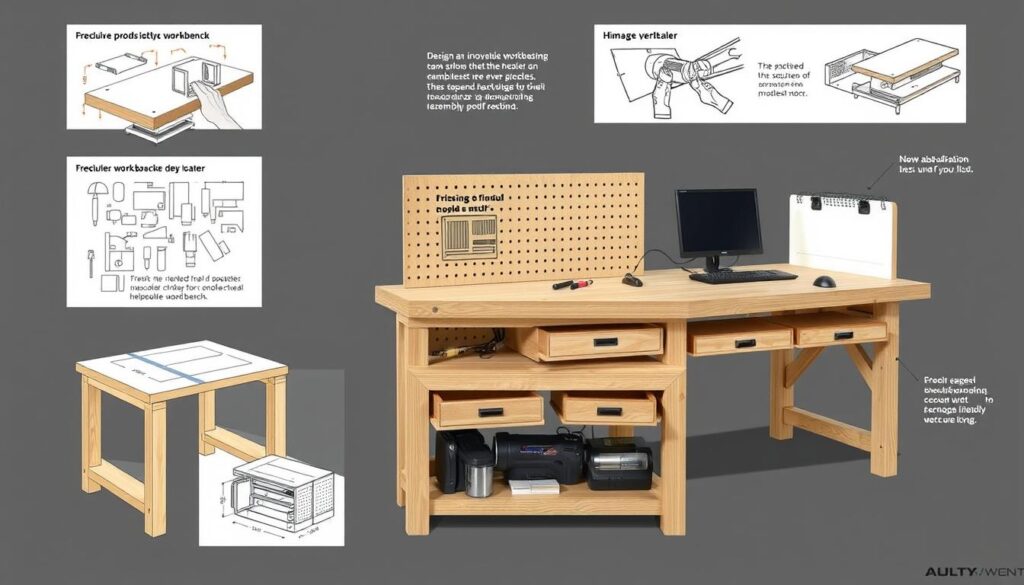
Modular workbench systems offer unparalleled flexibility for small workshops, allowing you to adapt your workspace to various projects and space constraints. These systems enable you to quickly fold out, slide out, and pivot into position all the tools and work areas you need.
Customisable Components for Your Needs
You can configure modular workbenches to suit your specific requirements, incorporating various modules such as work surfaces, tool mounts, and storage components. This customisability ensures that your workbench meets your precise needs.
Storage Integration Options
Modular workbench systems often include clever storage solutions, such as drawers and shelves, to keep your tools and materials organised. Effective storage integration is key to maintaining a clutter-free and efficient workspace.
By adopting a modular workbench system, you can create a highly adaptable workspace that grows with your needs, ensuring compatibility between components and maximising your productivity.
Knock-Apart Workbenches for Easy Storage
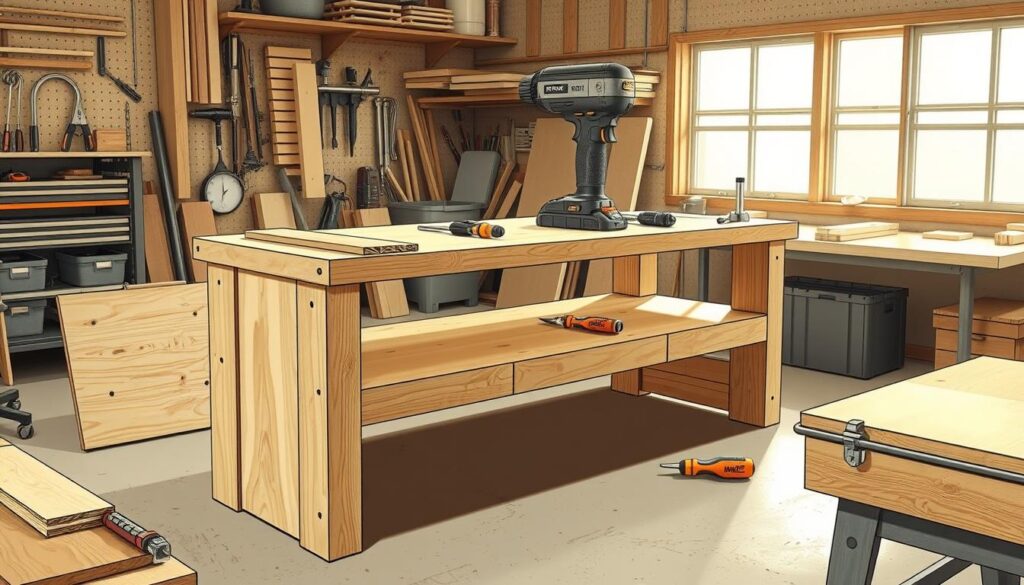
Maximise your workshop space with a knock-apart workbench that can be easily disassembled. A knock-apart workbench is made from a full sheet of 5/8-inch plywood for the interlocking base stand and a sheet of 3/4-inch plywood for the work surface and shelves, plus four 10-ft lengths of 1×3 pine for edge banding and cleats.
Tool-Free Assembly and Disassembly
The clever joinery systems used in knock-apart workbenches allow for solid construction when assembled while enabling quick disassembly without tools. You can explore various interlocking mechanisms, from simple notched joints to more sophisticated systems with minimal hardware.
Material Considerations for Durability
When designing your knock-apart workbench, consider the balance between durability, weight, and cost. Using high-quality plywood and robust pine for the frame ensures your workbench remains sturdy and reliable. You should also consider surface treatment options that protect your workbench while withstanding the wear of frequent handling during assembly.
Utility Workbenches with Minimal Footprints
Maximising workspace in compact areas is achievable with the right utility workbench. These workbenches are designed to be functional without taking up too much space, making them ideal for small garages or utility rooms.
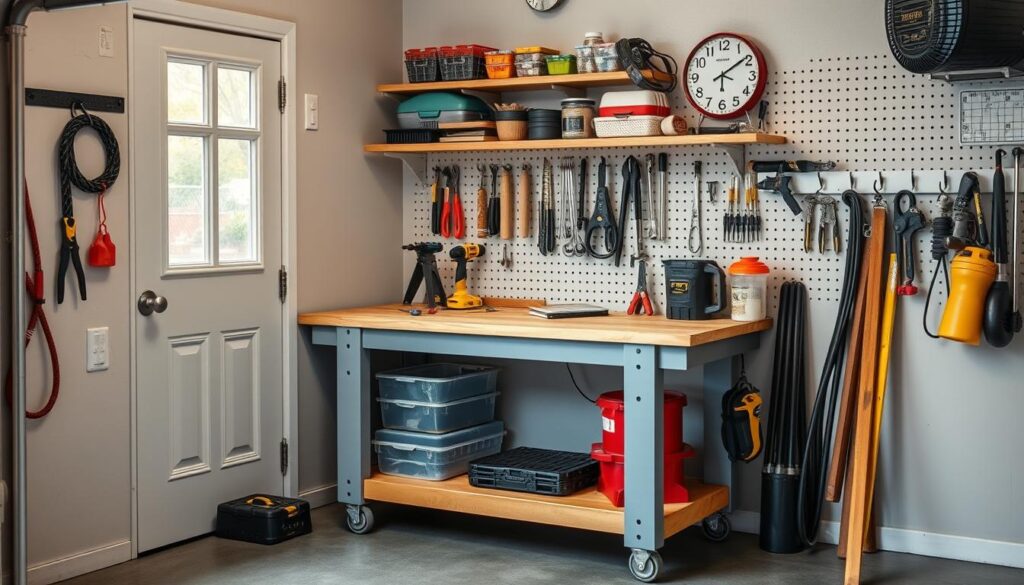
Maximising Wall Space Usage
To make the most of your wall space, consider wall-mounting your utility workbench. This not only saves floor space but also keeps your work surface at a comfortable height. By utilising vertical space, you can have ample room for your DIY projects without cluttering your garage.
Under-Bench Storage Solutions
Incorporating storage beneath your workbench is crucial for maintaining a clutter-free workspace. You can install drawers or shelves to keep your tools and materials organised and within reach. This approach ensures that your workbench remains functional and efficient, even in the smallest of spaces.
Adjustable-Height Workbenches for Versatility
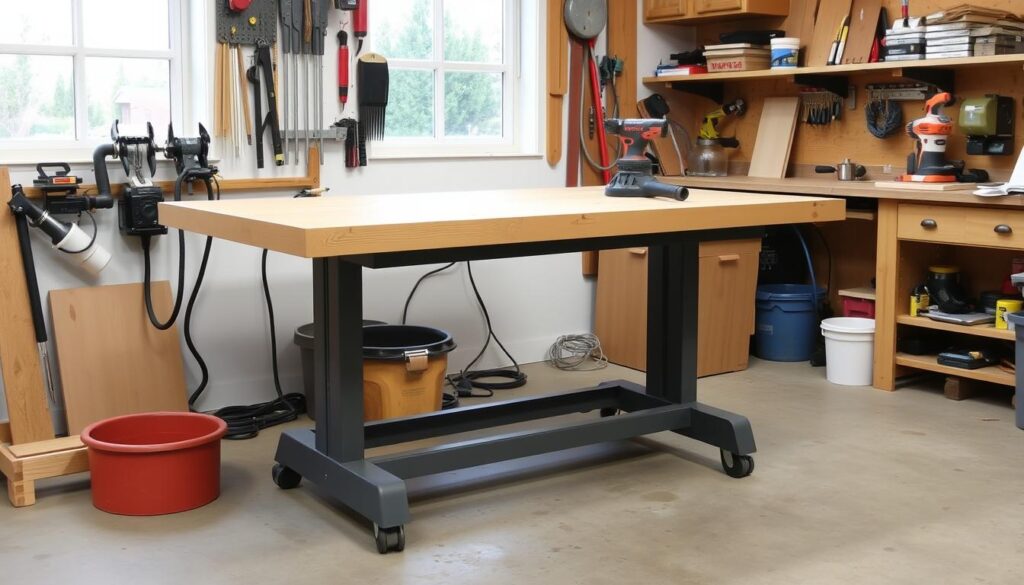
In a workshop where projects vary in size and complexity, an adjustable-height workbench is invaluable. You can benefit from ergonomic advantages by working at the optimal height for different tasks, reducing strain and improving productivity.
Benefits of Variable Working Heights
You can enjoy health advantages by alternating between sitting and standing positions while working on various DIY projects. This flexibility helps prevent fatigue and promotes a healthier working environment.
DIY Height Adjustment Mechanisms
You can create your own adjustable-height workbench using simple mechanisms. For instance, using ABC boxes made with sides of different dimensions can provide a variable-height assembly table base by rotating or standing them on end to achieve different working heights. You can explore lightweight workbenches for inspiration on designing your DIY workbench with adjustable legs.
Conclusion: Choosing the Right Portable Workbench for Your Space
To maximise your workspace, it’s essential to consider various portable workbench designs. When selecting a workbench, you must assess your primary workshop needs to determine which space-saving features are most important.
Key Considerations include evaluating the trade-offs between portability, stability, work surface area, and storage capacity. You can combine different workbench styles or adapt them to create a customised solution for your unique space.
It’s also crucial to future-proof your workbench choice to accommodate evolving project needs and skill levels. Planning for workbench accessories and add-ons can enhance functionality without compromising space efficiency.
By understanding maintenance considerations for different portable workbench designs, you can ensure longevity and reliable performance. Exploring real-world examples of successful small-space workshop setups can provide valuable insights into effective workbench solutions.
